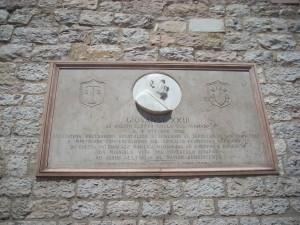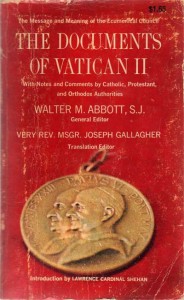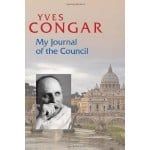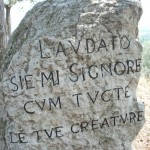by Yves Congar, OP
Liturgical Press, 2012
Even as my arteries and my religious views harden with age, I remain a daughter of Vatican II. The first session of the council was officially convened on my 12th birthday in 1962, and the fruits of the council were the single most important influence on my faith formation. As I’ve written here before, I still consider myself a Catholic of the John XXIIIrd Generation, and proud of it. I carried a well-thumbed copy of the Little Red Book, Catholic Version—The Documents of Vatican II, edited by Walter M. Abbott, SJ—through my high school years with the original nuns-thrown-under-the-bus, the IHMs of Los Angeles, and on into my 40 years in catechetical media and publishing. My return to the Church after a long lapse was in part triggered by seeing the plaque at the Basilica of St Francis in Assisi commemorating John XXIII’s visit to Assisi to ask Francis’s blessing on the council, and feeling the call to be back among folks who answer Christ’s continual call to “Go, rebuild my Church.” And since my reversion, though I agree that the ‘spirit of Vatican II’ has suffered from abuse and atrophy on both ecclesiological extremes, I continue to read the documents the council produced with awe at their depth and richness.
So I was delighted to be offered the chance to review Yves Congar’s My Journal of the Council. In 1,000+ pages (counting extensive front and back matter and footnotes that often eat up half a page—don’t bother reading them, they exist solely to identify the gabillion names Congar drops), My Journal publishes the near-daily notes on the council, from its preparatory sessions through the fourth official session, kept by the French Dominican theologian who had such a profound influence on the council’s ecclesiology and, in particular, its approach to ecumenism and interfaith relationships.
 It’s a fascinating, frustrating, harrowing, hilarious read. The proscription against watching how sausage is made also applies to the conciliar expression of doctrine, I suspect. Nothing in Fr Abbott’s neat little red paperback collection of documents prepared me for the utter (seeming) chaos in which the Holy Spirit worked to get ’em done, or the collection of flawed, vain, petty, ambitious, brilliant and/or clueless (i.e., human) characters through whom the Spirit moved to do so.
It’s a fascinating, frustrating, harrowing, hilarious read. The proscription against watching how sausage is made also applies to the conciliar expression of doctrine, I suspect. Nothing in Fr Abbott’s neat little red paperback collection of documents prepared me for the utter (seeming) chaos in which the Holy Spirit worked to get ’em done, or the collection of flawed, vain, petty, ambitious, brilliant and/or clueless (i.e., human) characters through whom the Spirit moved to do so.
Congar, on the other hand, holds nothing back. It’s no wonder he stipulated that these memoirs could not be released until after 2000; ears are buzzing and sod spinning in ecclesial graves around the world. Other reviewers have noted examples of Congar’s keen skewering of those with whom he disagreed—Cardinal Ottaviani, chief defender of the ancien regime of monarchical papacy and Vatican bureaucracy, for example, is consistently described in terms disparaging enough that I expected to find ‘buffoon: see Ottaviani’ as an index entry—but he often saw even his early allies, like the French Jesuit Jean Daniélou, through a slightly jaundiced eye:
Fr Daniélou does not examine things too closely. . . . He is extraordinary. Whether you turn him upside down or any other way, he always falls on his feet. (p. 292)
But it’s not Congar the caricaturist—or Congar the quintessential Frenchman, appalled enough to note in CAPITAL LETTERS the bad accents of bishops from the French colonies, or quick to take potshots at all things Roman, especially the weather (“Terrible weather: snow driven by the wind. Impossible to find a taxi!” p. 721); or Congar the impatient critic of all things liturgically swishy and ostentatious (“The Veni Creator was sung, alternately with the Sistine Choir, which is nothing but an opera chorus . . . elegant crooning by paid professionals,” p. 87); or Congar the suffering (but not silently) servant, recounting the impossibility of maintaining his 24/7 schedule of consulting, writing, preaching, teaching, and traveling while living with a mysterious, painful, and debilitating neurological disease (“This is THE worst day that I have had. I can no longer walk and have absolutely no strength. I am dragging myself along with the gait of a cripple,” p. 412); or even Congar the theologian, passionately applying an oilcan to those rusty window hinges so that Christ and his Church might engage with the world unencumbered by imperial baggage and baroque accretions (“All this heavy and costly apparatus, prestigious and infatuated with itself, imprisoned in its own myth of seigneurial grandeur, belongs to the non-Christian part of the Roman Church and it is this that . . . prevents its opening out to a fully evangelical and prophetic task,” p. 93)—that is the real reason to read My Journal. Here are the reasons:
 Because whatever you feel about the Second Vatican Council, we are all of us—Catholic or not, liberal or conservative, trad or happyclappy—its sons and daughters. The council is as much a part of who we are today as a Church and a world as anything, and the more we know about our roots, the better and stronger and truer we will grow in this Year of Faith. Feel free to boo the parts that piss you off (Congar certainly did); myself, I think Paul Philibert’s preface is whiny claptrap, but those of my age cohort who ride the bus with nuns will eat it up.
Because whatever you feel about the Second Vatican Council, we are all of us—Catholic or not, liberal or conservative, trad or happyclappy—its sons and daughters. The council is as much a part of who we are today as a Church and a world as anything, and the more we know about our roots, the better and stronger and truer we will grow in this Year of Faith. Feel free to boo the parts that piss you off (Congar certainly did); myself, I think Paul Philibert’s preface is whiny claptrap, but those of my age cohort who ride the bus with nuns will eat it up.
Because it will help you remember—or, for most of you who weren’t around, recognize—the heady days of the Church’s Arab Spring. Whatever you think of what came after Vatican II, My Journal is a couple of pounds of proof that we are better off now than we were 50 years ago. That we laity can scrap about that in public and in comboxes and even at the Synod on the New Evangelization is only one of the many hard-won fruits of the council. It’s also fun, in these days of people writing off the USCCB as lily-livered liberals, to note that the US hierarchs at the council come off, in Congar’s view, as intransigent political reactionaries concerned only with padding the investment portfolios they started when they were Wall Street brokers. Where’s a TARDIS when you need one? Time travel would so help dissolve the polarizations we fall into when we forget about swinging pendulums!
Because it will astonish you that anything at all got done. If a camel is a horse designed by a committee, try to think about what it takes to develop definitive doctrinal statements by committee . . . after committee . . . after committee. Then imagine that the members of these committees, most of whom do not speak one another’s native languages, must do this work in a language native to none of them: Latin. Imagine that the process is exquisitely boring (“Many bishops headed for the bar,” Congar notes, a couple of hundred times, and you’ll want to do the same if you read the transcript of every discussion). Imagine that this work is being done in the absence of electric typewriters, photocopiers, computers, faxes, overnight mail, the Internet, cellphones, or iAnything: drafts are created in longhand or painstakingly typed with layers of carbon paper, translated, circulated by hand or snail mail, revised, returned, read aloud, commented on, and lathered, rinsed, repeated over and over again. And all this is played out in the almost unbearable tension between the immovable object of papal primacy and the irresistible force of collegiality, the push of institution and the pull of mission, the Church and the World.
Because it will prove, if you need proof, that the Holy Spirit is alive and at work. Cf, all of the above.
In spite of his frustrations and his daily conviction that his health would not permit him to participate in the council one day more, Yves Congar endured, and the best of his intentions triumphed through God’s grace. He was faithful to the terms on which he agreed to serve the council and keep the journal:
After all, I have nothing to lose, and I must do my duty. It is always necessary to say what one knows or believes to be true. So I shall be frank and will try to be evangelical. The grace of the Lord will do the rest—Indeed it will! (p. 17)
Indeed it did. And so may each of us vow, and be as faithful.
_____
Visit the Patheos Book Club to learn more about Yves Congar and My Journal of the Council. Read excerpts and check out other bloggers’ responses to the book.












